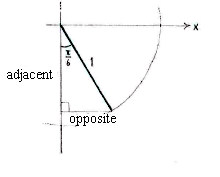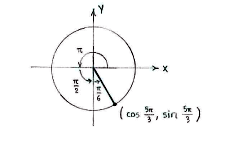Solution 4.2:4b
From Förberedande kurs i matematik 1
(Difference between revisions)
m |
|||
| (3 intermediate revisions not shown.) | |||
| Line 1: | Line 1: | ||
| - | {{ | + | We start by subtracting <math>2\pi</math> from <math>11\pi/3</math>, so that we get an angle between <math>0</math> and <math>2\pi </math>. This doesn't change the cosine value |
| - | < | + | |
| - | {{ | + | {{Displayed math||<math>\cos\frac{11\pi}{3} = \cos\Bigl(\frac{11\pi}{3}-2\pi\Bigr) = \cos\frac{5\pi}{3}\,\textrm{.}</math>}} |
| - | {{ | + | |
| - | < | + | Then, by rewriting <math>5\pi/3</math> as a sum of <math>\pi</math>- and <math>\pi/2</math>-terms, |
| - | { | + | |
| - | [[ | + | {{Displayed math||<math>\frac{5\pi}{3} = \frac{3\pi +\dfrac{3}{2}\pi +\dfrac{1}{2}\pi}{3} = \pi + \frac{\pi}{2} + \frac{\pi}{6}</math>}} |
| - | [ | + | |
| + | we see that <math>5\pi/3</math> is an angle in the fourth quadrant which makes an angle <math>\pi/6</math> with the negative ''y''-axis. | ||
| + | |||
| + | [[Image:4_2_4b1.gif||center]] | ||
| + | |||
| + | With the help of an auxiliary triangle and a little trigonometry, we can determine the coordinates for the point on a unit circle which corresponds to the angle | ||
| + | <math>5\pi/3\,</math>. | ||
| + | |||
| + | {| width="100%" | ||
| + | |width="50%" align="center"|[[Image:4_2_4_b2.gif]] | ||
| + | |width="50%" align="left"|<math>\begin{align}\text{opposite} &= 1\cdot\sin\frac{\pi}{6} = \frac{1}{2}\\[5pt] \text{adjacent} &= 1\cdot\cos\frac{\pi}{6} = \frac{\sqrt{3}}{2}\end{align}</math> | ||
| + | |} | ||
| + | |||
| + | The point has coordinates <math>(1/2,-\sqrt{3}/2)</math> and | ||
| + | |||
| + | {{Displayed math||<math>\cos \frac{11\pi}{3} = \cos\frac{5\pi}{3} = \frac{1}{2}\,\textrm{.}</math>}} | ||
Current revision
We start by subtracting \displaystyle 2\pi from \displaystyle 11\pi/3, so that we get an angle between \displaystyle 0 and \displaystyle 2\pi . This doesn't change the cosine value
| \displaystyle \cos\frac{11\pi}{3} = \cos\Bigl(\frac{11\pi}{3}-2\pi\Bigr) = \cos\frac{5\pi}{3}\,\textrm{.} |
Then, by rewriting \displaystyle 5\pi/3 as a sum of \displaystyle \pi- and \displaystyle \pi/2-terms,
| \displaystyle \frac{5\pi}{3} = \frac{3\pi +\dfrac{3}{2}\pi +\dfrac{1}{2}\pi}{3} = \pi + \frac{\pi}{2} + \frac{\pi}{6} |
we see that \displaystyle 5\pi/3 is an angle in the fourth quadrant which makes an angle \displaystyle \pi/6 with the negative y-axis.
With the help of an auxiliary triangle and a little trigonometry, we can determine the coordinates for the point on a unit circle which corresponds to the angle \displaystyle 5\pi/3\,.

| \displaystyle \begin{align}\text{opposite} &= 1\cdot\sin\frac{\pi}{6} = \frac{1}{2}\\[5pt] \text{adjacent} &= 1\cdot\cos\frac{\pi}{6} = \frac{\sqrt{3}}{2}\end{align} |
The point has coordinates \displaystyle (1/2,-\sqrt{3}/2) and
| \displaystyle \cos \frac{11\pi}{3} = \cos\frac{5\pi}{3} = \frac{1}{2}\,\textrm{.} |

